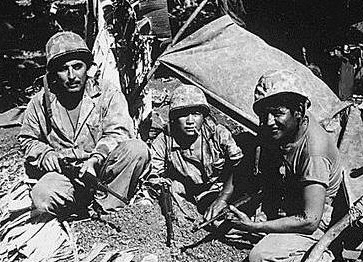![]() The Pacific War Online Encyclopedia
The Pacific War Online Encyclopedia
|
| Previous: Navajo Class, U.S. Fleet Tugboats | Table of Contents | Next: Naval Disarmament Treaties |

U.S. Navy. Via Wikipedia
Commons
The Navajo Code
Talkers were a group of about 400 native Americans from the Navajo
tribe (Diné) of New Mexico and Arizona who were trained by the Marine Corps
as radiotelephone operators. The Code Talkers transmitted to each other
in their native tongue, which they developed into a remarkably secure
form of communication. Code Talkers were first used in the Guadalcanal campaign and were
subsequently assigned to every division,
Raider battalion,
and parachute battalion in the Corps.
The Code Talkers were a success at secure
communications in part because Navajo or Diné bizaad is an
extremely complex language that lacks a written alphabet and is spoken
only in a small area of the American
Southwest. It is linguistically very distant from either Japanese or
Western languages, and it was estimated that only 30 non-Navajos, none
of whom were Japanese, understood
Navajo in 1941. At the same time, the Navajo were one of the most
numerous tribes of native Americans, making it possible to recruit a
sufficient number of Navajo speakers.
The Code Talkers did not speak to each other in plain
Navajo. Rather, their communications were superencrypted. About 450 of
the most frequently used military terms were represented by individual
Navajo words, such as dah-he-tih-hi
("hummingbird") for "fighter aircraft." Other English words were
spelled out by using Navajo words whose English equivalent began with
the desired letter. Thus, the word "Navy" could be transmitted as tsah ("needle")
wol-la-chee ("ant") ah-keh-di-glini ("victor") tsah-ah-dzoh ("yucca"). Since there
were numerous ways to spell out an English word in this manner, the
Navajo Code was a form of injective cypher, in which each element of
the plaintext could be represented by a very large number of
cyphertexts, increasing the security.
A Navajo Code transmission sounded like a random hash
of Navajo even to a native speaker, so use of the Navajo Code required
considerable training. This was
fortunate, as the Japanese somehow learned that the communications they
were having so much trouble deciphering were in Navajo, but they were
unable to break the superencryption even with the unwilling help of
Navajo prisoners of war
captured in the Philippines
in 1942.
The system was so valuable that it was kept secret even
after the Japanese surrender,
and saw use as late as the early Vietnam War era. The details of the
program were not declassified until 1968, although it was very briefly
mentioned in Morison's 1953 history of the Guam
campaign (with no mention of the superencryption.) As a result, the
Code Talkers received no formal public recognition from the U.S.
government for their invaluable service until 1982.
References
Morison
(1953)
Naval Historical
Center (accessed 2009-4-23)
The Pacific War Online Encyclopedia © 2009 by Kent G.
Budge. Index